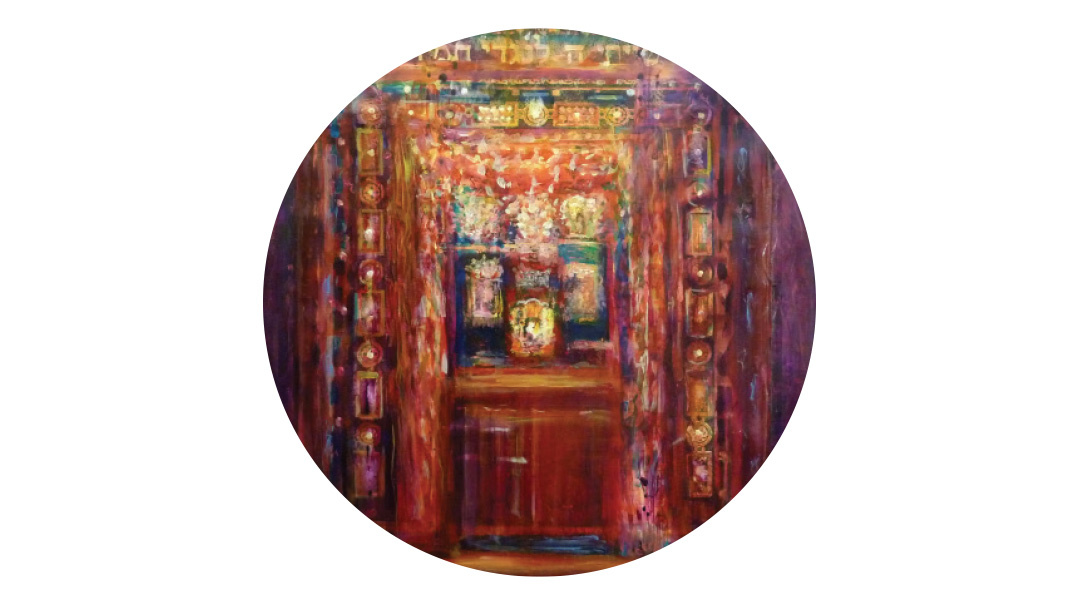Stepping Stones


I have taken off my cloak how will I put it back on? I have washed my feet how can I soil them?” (Shir Hashirim 5:3)
Rashi hears in this verse the cry of a despairing sinner who finds no purpose in donning his travel garments for he sees neither route nor recourse no possibility of retracing his steps. With the next verse however comes a ray of hope: “Dodi shalach yado min hachor — My Beloved stretched His Hand through the opening and my heart was stirred.”
What is this opening? And what is the message that transformed the offender’s perspective?
We’re all too familiar with sinning. Our personal pathways as well as the landscape of Klal Yisrael’s history are strewn with obstacles and stumbling blocks. We often falter or stumble and it can take great effort to regain our footing.
The Torah doesn’t gloss over historical fact; it chronicles our People’s challenges and errors. In particular the journey through the Midbar to Eretz Yisrael is replete with lapses and letdowns detours and disappointments.
Chazal refer to the Dor Hamidbar the desert generation as the Dor Deiah the generation that uniquely possessed the precious quality of daas. Their knowledge of Hashem permeated their very beings so that they lived life with dveikus with constant focus and awareness of His presence and attention.
Against this backdrop their sins however few (there were ten in all) seem particularly egregious and they resulted in severe punishments. The Mishnah (Avos 5) labels these unfortunate events as “nisyonos.” The Maharal explains that the root word is neis miracle. It was surprising and unexpected that the nation would sin. After all these were the people who held great promise; they had witnessed Yetzias Mitzrayim the Splitting of the Sea Matan Torah and the miracles of survival in the wilderness.
How can we reconcile these two visions of the Dor Hamidbar? And how can we explain our own trajectory of rising and falling? Of becoming inspired and then losing momentum? Smooth passage through This World seems to elude us. If life is a journey why can’t we move directly from station to station toward our destinations?
Travel Patterns
A closer look at the progress of the Dor Hamidbar can enlighten us about our own travel patterns. Rav Dessler explains that the open miracles witnessed by the newly freed nation were undeserved an “awakening from Above.” They beheld prophetic revelations beyond their level a glimpse of the clarity and glory that could be their own.
But an unearned gift of this sort can only be temporary for man was created to reach shleimus perfection by his own efforts. In the Midbar the initial inspiration gave way to loss of clarity to disconnect and distrust. They complained about food water and travel conditions. They feared Moshe’s absence and fashioned the eigel; they were afraid to enter Eretz Yisrael and cried on the night of Tishah B’Av.
After each setback they had to scramble back to their feet on their own. They would painfully gradually regain the emunah and bitachon that had once come so easily to them. But this time around it would be their own acquisition for it would result not from external impression but from internal conviction.
What then was the purpose of the original gift? Was the initial inspiration in the Midbar merely a teaser? The Rambam says no. He likens this process to a flash of lightning that lights up the road for a desperate traveler who has lost his way on a dark stormy night. A second later he is again in the dark but he can forge ahead a bit more securely guided by the memory of the flash. In similar fashion the desert revelations paved the way for the Dor Hamidbar to grow into greatness.
Fascinatingly the process by which one acquires Torah follows the same pattern. The fetus in the womb is taught by a malach and absorbs the knowledge effortlessly. Alas this priceless gift is withdrawn before birth and the newborn child must spend his life regaining it with great effort and toil. Nevertheless the knowledge remains imprinted on his neshamah. The Torah he studies during his lifetime is familiar and it’s as if he’s relearning it — a far easier task.
Rabbi Akiva Tatz writes in Living Inspired: “That’s the pattern of life short-lived inspiration and lengthy battles. The tools needed are determination perseverance and a stubborn refusal to despair. And the work of remembering the flash of light when it seems impossible is emunah.”
Seen from this perspective challenges are not necessarily a sign of failing. Rather they are our Creator’s way of provoking us to grow into our particular missions. To a person grappling guiltily with issues of emunah and bitachon a wise person once counseled “Perhaps this is the very purpose for which your neshamah has entered the world.”
The Baal Shem Tov famously compares our life challenges to a child learning to walk. His mother holds out her arms to him but then backs away as he approaches. Far from a lack of compassion her distancing is the best way to prod him forward — to help him gain the ability to walk.
In the case of the Dor Hamidbar the ultimate goal was not to remain in the desert indefinitely but to enter Eretz Yisrael and live a more natural existence capturing and settling the land and engaging in agriculture and commerce. They needed to maintain their dveikus b’Hashem without witnessing a steady flow of miracles just as the child must step forward without leaning on his mother. The preparation for this reality began in the Midbar.
The Shelah notes that many challenges in the Midbar occurred after a high point: Moshe’s perceived delay in returning after Matan Torah led to Cheit Ha’eigel; the spy mission at the final approach to the Land led to Cheit Hameraglim. It was precisely at these times that Klal Yisrael was challenged to walk further on its own.
Try and Try Again
The child however doesn’t always progress as his mother coaxes him forward. Sometimes he falls. When we fail how can we muster the courage to stand up and try again?
Mishlei declares “Sheva yipol tzaddik v’kam — a tzaddik falls seven times and rises.” In a well-known response to a discouraged talmid Rav Hutner explains that these seven falls are not incidental to the tzaddik’s ascent; they actually facilitate it. In a similar vein the Slonimer Rebbe writes that the failures in the Midbar served to “inoculate” the people against future mistakes in Eretz Yisrael.
Let us be clear. Hashem does not overlook our sins. Without teshuvah we will be held accountable for every lapse and the din is exacting. It’s far better not to sin but if one fails that very failure can be utilized to spur repentance and future growth.
A sagacious person once commented “The difference between stumbling blocks and stepping stones is how you use them.” How does a stumbling block become a stepping stone?
The Gemara (Menachos 29b) makes this fascinating observation: “Why was This World created with the letter hei? Because it is like a three-walled entranceway. Whoever wishes to leave [i.e. to sin] can drop right out. And why is there a gap between the leg of the hei and its roof? So that if man repents he will have a way to come back. Why can’t he return the way he left? It wouldn’t work.”
The wide opening at the bottom of the hei teaches us that man has free choice to sin and exit This World. It’s all too easy to fall into the abyss. Yet the narrower opening on the upper left teaches us that there’s always a way back. Yet it’s a different route for once man sins he faces an uphill struggle and the straight way back is unavailable to him.
Donning Travel Garments
Teshuvah is an arduous climb. A person who seeks to repent must raise himself up to a higher level and force his way through the narrow space. Yet once he does so he is higher than before. He is closer to Hashem for he has the additional gain of having overcome his yetzer hara.
This process echoes the Megillah’s message of “Dodi shalach yado min hachor — My Beloved stretched His Hand through the opening.” This says the Ben Ish Chai is the opening of the hei. (“Yad ” Hand is composed of a daled and a yud the two letters that combine to form the letter hei.) Hashem Himself reaches out to the sinner; his sin can literally become a stepping stone to reconciliation and elevation as he reaches up to the narrow opening.
This is true not only philosophically but practically as well. A failure can shock us into self-improvement. It can bring about our yearning to repent and reconnect. We can also allow our failures to be our teachers. A mistake can alert us to an inner flaw and the work needed to correct it. Imagine a person who acts imprudently and then searches his heart for an explanation of his own behavior. Suppose he comes to the realization that he’s excessively concerned with how other people look at him. If he acts upon this discovery his original misstep becomes a stepping stone to growth.
As the Nesivos Shalom puts it to create magnificent jewelry we need artisans but we also need miners. Sometimes it’s necessary to dig deeply into the earth to unearth something precious. This is the concept of yeridah l’tzorech aliyah of sinking and then soaring of turning a liability into an asset.
Rav Aharon Feldman points out (in The Juggler and the King) that the shape of the hei doesn’t only teach us about our personal pathways it also traces the course of Jewish history. The goal of creation was for man to achieve complete closeness with Hashem. When Adam sinned he was ejected from Gan Eden. Because evil was now part of him the climb back to Gan Eden would be difficult but not impossible; he’d have to seek a new entrance to get back.
Avraham Avinu took up this challenge and his descendants would slowly move mankind toward this goal. Each era of Jewish history represents another test in the destruction of evil. Sometimes we pass these tests and sometimes we fail. Each failure results in another opportunity for success but with greater difficulty for more spiritual effort is required to reach the opening and squeeze back in. The cumulative effect of all these tests will weaken the power of evil and usher in the Era of Mashiach.
Perhaps this is why the Gemara (Sanhedrin 96b) gives Mashiach the name Bar Nafli “the son of the fallen ” for he is the product of the falls and failures of Klal Yisrael. Each time we repent rebuild and restore we are in effect donning our travel garments again and stepping forward to greet Melech HaMashiach.
Sources include Nesivos Shalom Rav Dessler Rabbi Akiva Tatz Understanding the Alef-Beis by Dovid Leitner.
Originally featured in Family First Issue 547. Mrs. Shani Mendlowitz is a teacher at Bais Yaakov Seminary in Montreal and is a popular lecturer for adults.
Oops! We could not locate your form.







